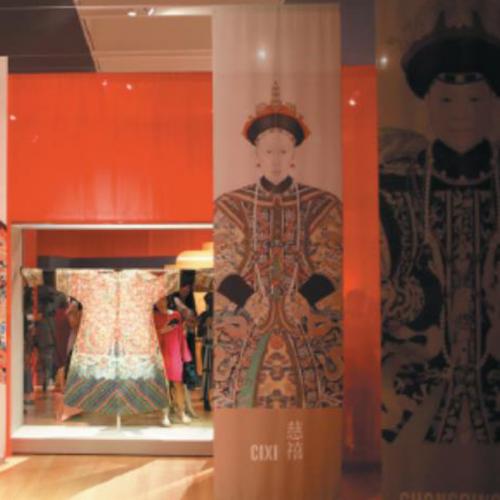



Ancient artifacts help people overseas to better understand the country.
In the 1690s, Salem, Massachusetts, cemented its place in history for its notorious witch hunts. But things are different now. From August to February, the small city of about 40,000 inhabitants in the United States attracted favorable attention for its exhibition on high-ranking historical Chinese women.
The exhibition, Empresses of China's Forbidden City, on loan from Beijing, features around 200 artifacts telling the stories of the most powerful women of the Qing Dynasty (1644-1911).
About 115,000 people visited Salem's Peabody Essex Museum to view the exhibits.
"Visitors loved this exhibition and at least one visited it seven times," said Daisy Yiyou Wang, the curator, in written answers to questions from China Daily.
The Forbidden City in Beijing - China's imperial palace from 1420 until the fall of the Qing - is now officially known as the Palace Museum, and it houses 1.86 million cultural relics.
To select just a few hundred items from the massive inventory, Wang and her team surveyed 300 Salem residents to identify the topics they found most interesting.
"We were not surprised to find that most visitors had never heard the names of the empresses," she wrote. "They knew little about Chinese history and culture, and had some misconceptions about China. But they had a high level of curiosity about the Chinese empresses and the Forbidden City."
The team focused on making the empresses accessible to visitors through universal experiences, such as love, death, birthday celebrations and biographical details, while also providing a wealth of basic information about Chinese history and values.
"We countered the stereotypical view about Chinese women in history as cloistered and footbound by displaying footwear for women with normal feet, as the Qing empresses did not practice footbinding," Wang said.
"Not all good research or the best objects lead to the best exhibitions, but all the best exhibitions start with innovative, deep research and the most compelling objects."
One visitor to the exhibition in Salem wrote in the comments book: "Extraordinarily beautiful. So wonderful to see a glimpse into an area of history so often ignored in the West."
Under the auspices of the Peabody Essex Museum, the exhibition is continuing its tour of the US. At the end of the month, it will open at the Smithsonian's Freer and Sackler Galleries in Washington.
"It will be an exciting platform for us to celebrate the role of cultural and people-to-people exchanges as we mark the 40th anniversary of the establishment of the US-China diplomatic relationship," Wang said.
Wang Yamin, chief exhibition curator of the Palace Museum and a member of the National Committee of the 13th Chinese People's Political Consultative Conference, said: "China has a long history, which may still be mysterious in the eyes of many foreigners. However, cultural relics and artworks can explain our civilization without any language barriers.
"As a big museum housing so many treasures, it's a duty for our institution not only to serve domestic visitors, but also to promote the best parts of traditional Chinese culture worldwide."

Networks
Sending exhibitions to tour overseas has become a common way for Chinese museums to display the country's brilliant civilization.
Nearly 300 exhibitions of cultural relics have been taken overseas since 2013, according to the National Cultural Heritage Administration. There were 44 last year alone.
From September to November, an exhibition called Treasures of China visited Riyadh, capital of Saudi Arabia.
The show, drawn from more than 200 collections in 13 institutions, represented the largest exhibition of Chinese cultural relics in the history of the Arabian Peninsula.
Last year, more than 120 Terracotta Warriors and other artifacts dating back 2,000 years were displayed in Liverpool, England.
More opportunities for cooperation between museums in China and overseas have emerged as a result of the adoption of new formats.
For example, the International Alliance of Museums of the Silk Road and the BRICS Alliance of Art Museums and National Galleries were established last year, enabling more frequent exchanges between national museums in related countries.

"These alliances explore a new way for institutions from different countries to stage cooperative exhibitions and nurture expertise together," said Wang Chunfa, director of the National Museum of China and a member of the National Committee of the 13th CPPCC.
He noted that the new alliances have made a number of surprising discoveries, such as the recognition that some of the relics in the National Museum in New Delhi, India, originated in Dunhuang, an old city in Gansu province that was a well-known hub on the ancient Silk Road.
The relics have never been exhibited publicly, but thanks to the new alliances they will soon be displayed in several countries to reflect the prosperous history of the ancient Eurasian trade route.
"Chinese cultural relics reflect the thoughts, morals and humanity of our nation," Wang Chunfa said. "These traditions can offer important reference points for all human beings."
Despite that, some experts claim that it is not enough to simply showcase antiques.
"If we just display cultural relics from ancient times, overseas audiences still feel detached sometimes," said He Yun'ao, a professor from the School of History and Archaeology at Nanjing University in Jiangsu province and a member of the National Committee of the 13th CPPCC.
"Stories need to be better told through multiple forms," he said. "The exhibits need to be connected with modern China, so people overseas will better understand the country today."
To that end, the Palace Museum has made a number of moves.
For example, many replicas developed from relics have gained popularity in China. In response, the museum has organized a touring exhibition of these replicas.
The expo is visiting Tokyo, Sydney, Brussels, Seoul and other cities worldwide to illustrate how modern creativity can introduce traditional cultures to new audiences.

New promotions
Exhibitions are not the only way China is promoting greater knowledge of its cultural treasures overseas.
In 2017, The Nation's Greatest Treasures, a program produced by China Central Television, became an unexpected hit by adopting an entirely new approach to the topic.
Each 100-minute episode featured three key items from a major museum, introduced by entertainment stars through short dramas. Afterward, experts explained the cultural importance of each artifact, while members of the public shared stories about the items in a modern context.
The show was widely praised as a fresh approach to making cultural relics into "stars". On Douban, a major website for film and TV critics, the first and second seasons of the program were awarded 9 and 9.2 respectively out of a possible 10.
"The Nation's Greatest Treasures broke down the barriers between documentaries, variety shows and other familiar formats," said Lyu Yitao, the program's executive producer and a member of the 13th CPPCC National Committee.
"When we group them together, people can better see the in-depth cultural meaning of the relics."
The program also won plaudits overseas.
In October, at the 2018 edition of MIPCOM, a major trade expo for the global TV industry in Cannes, France, the show's format was licensed to the Endemol Shine Group, a production company in the Netherlands, to shine a spotlight on artifacts in museums across Europe.
"Chinese TV producers are used to introducing established formats from overseas," Lyu said.
"However, this time, every detail from the upcoming adapted shows will be identical to ours. That reflects our overseas counterparts' recognition of our creativity."
At the same expo, BBC World News signed an agreement with CCTV to make a documentary inspired by The Nation's Greatest Treasures to introduce Chinese relics worldwide.
A BBC production team will arrive in China to begin shooting soon, according to Lyu.
He added the third season of the program on CCTV will feature Chinese artifacts held in museums overseas.
"These relics are like our children who have lived abroad for a long time," he said. "People want to see whether they are living well."

Academic exchanges
While knowledge of China's cultural heritage may have deepened among people overseas, He, from Nanjing University, considers academic exchanges to be the other side of the same coin.
"Cultural self-confidence has been advocated in China in recent years, and we archaeologists may be the ones who are naturally confident," he said.
"When we unearth relics dating back tens of thousands of years, we can clearly see how Chinese civilization originated and advanced toward today without interruption. Confidence is not only about emotion; it is rooted in a rational spirit."
He added that recent achievements in archaeological studies in China deserve greater global exposure.
"We need hard work, of course, but our voice also needs to be heard," he said.
Ma Xiaolin, director of the Henan Museum in Zhengzhou, the provincial capital, and a member of the National Committee of the 13th CPPCC, said China is home to 33 professional archaeology journals, but only three have foreign language editions, and not every paper in them is translated.
Speaking at the current session of the CPPCC National Committee, he noted that the lack of academic journals published in foreign languages has become a bottleneck preventing the rest of the world from comprehensively understanding Chinese history.
"We've made great achievements in terms of archaeology. However, even many top-level foreign archaeologists don't know much about them, let alone general academics," he said, adding that the nation's archaeological journals should recruit foreign experts to expand their global influence.
Moreover, Chinese archaeologists have been using new ways to ensure their theories and methodologies are better known elsewhere - not on paper, but in person.
According to the National Cultural Heritage Administration, since 2016 archaeologists from nearly 30 academic institutions, universities and museums nationwide have taken part in 40 cross-border projects in 24 countries.
Two projects - one in Iran and one in Russia - are being led by Nanjing University. He, the professor, is a member of the expert panel, which is responsible for devising plans to preserve important sites. He views this as a way of promoting understanding of the protection of the nation's cultural heritage overseas.
"By learning more about other ancient civilizations, we can better understand our own," he said.
In 2017, he hosted an excavation of the ruins of a temple in Nantong, Jiangsu, that attracted visitors and missions from Japan during the Tang Dynasty (618-907).
"I was invited to deliver related lectures in Japan and South Korea last year, even though I hadn't finished the project. Many local media covered the events," he said.
"Our latest achievements in cultural heritage studies will travel to other countries faster than we can imagine if we can find the right method."
If you have any problems with this article, please contact us at app@chinadaily.com.cn and we'll immediately get back to you.